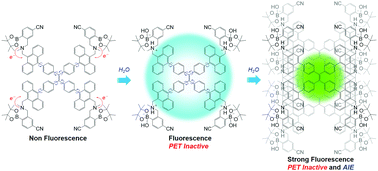Tetraphenylethene–anthracene-based fluorescence emission sensor for the detection of water with photo-induced electron transfer and aggregation-induced emission characteristics†
Abstract
As a fluorescent sensor for water over a wide range from low to high water content regions in organic solvents, we designed and developed a PET (photo-induced electron transfer)/AIE (aggregation-induced emission)-based fluorescent sensor EN-1 composed of a tetraphenylethene (TPE) core and four anthracene-(aminomethyl)-4-cyanophenylboronic acid pinacol esters (AminoMeCNPhenylBPin) as peripheral units. EN-1 showed an enhancement of the fluorescence band at around 450 nm originating from the anthracene skeleton with increasing the water content in THF in the low water content region below 1.0 wt%, which was attributed to the formation of the PET-inactive (fluorescent) species EN-1(H2O) by the addition of water molecules. With increasing the water content from 10 wt% to 50 wt%, the fluorescence intensity at around 500 nm originating from the TPE core gradually increased, which was attributed to the restricted intramolecular rotation (RIR) of TPE due to the increase in the viscosity of the THF–water mixtures. Furthermore, a significant enhancement of the fluorescence band at around 470 nm in the water content region above 60 wt% was observed due to the AIE characteristics associated with the aggregate formation of EN-1(H2O)-A in both PET-inactive and RIR states. The detection limit (DL) of EN-1 for water in the low water content region below 1.0 wt% in THF was 0.21 wt%, which was superior to that (DL = 0.49 wt%) of RS-1 composed of a TPE unit and an anthracene–AminoMeCNPhenylBPin unit. Moreover, the AIE characteristics of EN-1 were observed from the relatively low water content of 60 wt% compared with those of RS-1, which were observed in the high water content region over 75 wt%. The improvement of the DL value and AIE characteristics of EN-1 was ascribable to the fact that the four anthracene–AminoMeCNPhenylBPin units led to increased fluorescence emission originating from the anthracene skeleton and its low solubility in solvent–water mixtures, compared with RS-1. Consequently, this work reveals that EN-1 composed of a TPE core and four anthracene–AminoMeCNPhenylBPin units can act as a PET/AIE-based fluorescent sensor for the detection of water in a low water content region and from moderate to high water content regions in solvents.



 Please wait while we load your content...
Please wait while we load your content...
